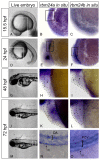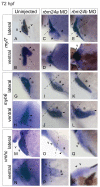Identification of RNA binding motif proteins essential for cardiovascular development
- PMID: 22011202
- PMCID: PMC3277282
- DOI: 10.1186/1471-213X-11-62
Identification of RNA binding motif proteins essential for cardiovascular development
Abstract
Background: We recently identified Rbm24 as a novel gene expressed during mouse cardiac development. Due to its tightly restricted and persistent expression from formation of the cardiac crescent onwards and later in forming vasculature we posited it to be a key player in cardiogenesis with additional roles in vasculogenesis and angiogenesis.
Results: To determine the role of this gene in cardiac development, we have identified its zebrafish orthologs (rbm24a and rbm24b), and functionally evaluated them during zebrafish embryogenesis. Consistent with our underlying hypothesis, reduction in expression of either ortholog through injection of morpholino antisense oligonucleotides results in cardiogenic defects including cardiac looping and reduced circulation, leading to increasing pericardial edema over time. Additionally, morphant embryos for either ortholog display incompletely overlapping defects in the forming vasculature of the dorsal aorta (DA), posterior caudal vein (PCV) and caudal vein (CV) which are the first blood vessels to form in the embryo. Vasculogenesis and early angiogenesis in the trunk were similarly compromised in rbm24 morphant embryos at 48 hours post fertilization (hpf). Subsequent vascular maintenance was impaired in both rbm24 morphants with substantial vessel degradation noted at 72 hpf.
Conclusion: Taken collectively, our functional data support the hypothesis that rbm24a and rbm24b are key developmental cardiac genes with unequal roles in cardiovascular formation.
Figures






Similar articles
-
Rbm24a and Rbm24b are required for normal somitogenesis.PLoS One. 2014 Aug 29;9(8):e105460. doi: 10.1371/journal.pone.0105460. eCollection 2014. PLoS One. 2014. PMID: 25170925 Free PMC article.
-
Knockout of rbm24a and rbm24b genes in zebrafish impairs skeletal and cardiac muscle integrity and function during development.Dev Dyn. 2025 May;254(5):420-435. doi: 10.1002/dvdy.743. Epub 2024 Sep 26. Dev Dyn. 2025. PMID: 39323318 Free PMC article.
-
Adamts18 deficiency in zebrafish embryo causes defective trunk angiogenesis and caudal vein plexus formation.Biochem Biophys Res Commun. 2020 Jan 22;521(4):907-913. doi: 10.1016/j.bbrc.2019.10.202. Epub 2019 Nov 9. Biochem Biophys Res Commun. 2020. PMID: 31711643
-
Rbfox-regulated alternative splicing is critical for zebrafish cardiac and skeletal muscle functions.Dev Biol. 2011 Nov 15;359(2):251-61. doi: 10.1016/j.ydbio.2011.08.025. Epub 2011 Sep 7. Dev Biol. 2011. PMID: 21925157 Free PMC article.
-
Modeling cardiovascular disease in the zebrafish.Trends Cardiovasc Med. 2008 May;18(4):150-5. doi: 10.1016/j.tcm.2008.04.002. Trends Cardiovasc Med. 2008. PMID: 18555188 Review.
Cited by
-
RNA-Binding Protein Rbm24 as a Multifaceted Post-Transcriptional Regulator of Embryonic Lineage Differentiation and Cellular Homeostasis.Cells. 2020 Aug 12;9(8):1891. doi: 10.3390/cells9081891. Cells. 2020. PMID: 32806768 Free PMC article. Review.
-
RBM24 in the Post-Transcriptional Regulation of Cancer Progression: Anti-Tumor or Pro-Tumor Activity?Cancers (Basel). 2022 Apr 6;14(7):1843. doi: 10.3390/cancers14071843. Cancers (Basel). 2022. PMID: 35406615 Free PMC article. Review.
-
RNA-Binding Proteins in Cardiomyopathies.J Cardiovasc Dev Dis. 2024 Mar 5;11(3):88. doi: 10.3390/jcdd11030088. J Cardiovasc Dev Dis. 2024. PMID: 38535111 Free PMC article. Review.
-
Alternative Splicing in the Heart: The Therapeutic Potential of Regulating the Regulators.Int J Mol Sci. 2024 Dec 4;25(23):13023. doi: 10.3390/ijms252313023. Int J Mol Sci. 2024. PMID: 39684734 Free PMC article. Review.
-
Rbm24, an RNA-binding protein and a target of p53, regulates p21 expression via mRNA stability.J Biol Chem. 2014 Feb 7;289(6):3164-75. doi: 10.1074/jbc.M113.524413. Epub 2013 Dec 19. J Biol Chem. 2014. PMID: 24356969 Free PMC article.
References
-
- Lints TJ, Parsons LM, Hartley L, Lyons I, Harvey RP. Nkx-2.5: a novel murine homeobox gene expressed in early heart progenitor cells and their myogenic descendants. Development. 1993;119:969. - PubMed
-
- Stainier DY, Fouquet B, Chen JN, Warren KS, Weinstein BM, Meiler SE, Mohideen MA, Neuhauss SC, Solnica-Krezel L, Schier AF. et al.Mutations affecting the formation and function of the cardiovascular system in the zebrafish embryo. Development. 1996;123:285–92. - PubMed
Publication types
MeSH terms
Substances
LinkOut - more resources
Full Text Sources
Molecular Biology Databases

